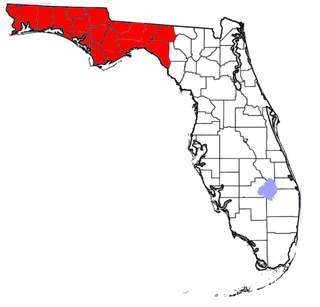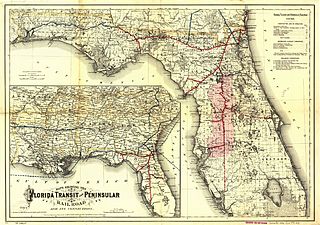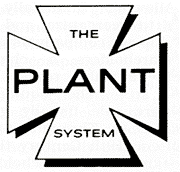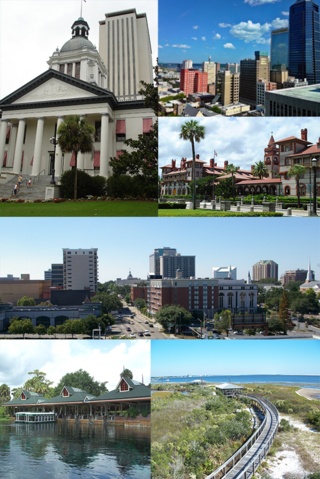
The Florida panhandle is the northwestern part of the U.S. state of Florida. It is a salient roughly 200 miles (320 km) long, bordered by Alabama on the north and the west, Georgia on the north, and the Gulf of Mexico to the south. Its eastern boundary is arbitrarily defined. It is defined by its southern culture and rural geography relative to the rest of Florida, as well as closer cultural links to French-influenced Louisiana, Mississippi, and Alabama. Its major communities include Pensacola, Navarre, Destin, Panama City Beach, and Tallahassee.

The Seaboard Air Line Railroad, which styled itself as "The Route of Courteous Service", was an American railroad that existed from April 14, 1900, until July 1, 1967, when it merged with the Atlantic Coast Line Railroad, its longtime rival, to form the Seaboard Coast Line Railroad. Predecessor railroads dated from the 1830s and reorganized extensively to rebuild after the American Civil War. The company was headquartered in Norfolk, Virginia, until 1958, when its main offices were relocated to Richmond, Virginia. The Seaboard Air Line Railway Building in Norfolk's historic Freemason District still stands and has been converted into apartments.

The South Florida Railroad was a railroad from Sanford, Florida, to Tampa, Florida, becoming part of the Plant System in 1893 and the Atlantic Coast Line Railroad in 1902. It served as the southernmost segment of the Atlantic Coast Line's main line. The line remains in service today and is now part of the Central Florida Rail Corridor in the Orlando metro area. The rest of the line remains under the ownership of CSX Transportation as part of their A Line.

The Florida Central and Peninsular Railroad was the final name of a system of railroads throughout Florida, becoming part of the Seaboard Air Line Railway in 1900. The system, including some of the first railroads in Florida, stretched from Jacksonville west through Tallahassee and south to Tampa. Much of the FC&P network is still in service under the ownership of CSX Transportation.

The Plant System, named after its owner, Henry B. Plant, was a system of railroads and steamboats in the U.S. South, taken over by the Atlantic Coast Line Railroad in 1902. The original line of the system was the Savannah, Florida and Western Railway, running across southern Georgia. The Plant Investment Company was formed in 1882 to lease and buy other railroads and expand the system. Other major lines incorporated into the system include the Savannah and Charleston Railroad and the Brunswick and Western Railroad.
The Tallahassee Railroad, headquartered in Tallahassee, Florida, was one of the first two railroads in Florida, starting operations in 1836 or 1837. It did not successfully use steam locomotives until 1855, with trains being pulled by mules for more than 20 years. The principal source of traffic on the railroad for many years was carrying cotton bales from Tallahassee to seaports on the St. Marks River.

Tallahassee station, also known as the Jacksonville, Pensacola and Mobile Railroad Company Freight Depot, is a historic train station in Tallahassee, Florida. It was built in 1858 and was served by various railways until 2005, when Amtrak suspended service due to Hurricane Katrina. It was added to the National Register of Historic Places in 1997.
The Florida Railroad was the first railroad to connect the east and west coasts of Florida, running from Fernandina to Cedar Key. The line later became part of the Seaboard Air Line Railroad, and, where still in use, is operated by CSX Transportation and the First Coast Railroad. The highway corridor of SR 24, US 301, and SR A1A/SR 200 closely parallels the former Florida Railroad.

North Florida, sometimes shortened to NorFlo, is a region of the U.S. state of Florida comprising the northernmost part of the state. Along with South Florida and Central Florida, it is one of Florida's three most common "directional" regions. It includes Jacksonville and nearby localities in Northeast Florida, an interior region known as North Central Florida, and the Florida Panhandle.

The Pensacola and Atlantic Railroad (P&A) was a company incorporated by an act of the Florida Legislature on March 4, 1881, to run from Pensacola to the Apalachicola River near Chattahoochee, a distance of about 160 miles (260 km). No railroad had ever been built across the sparsely populated panhandle of Florida, which left Pensacola isolated from the rest of the state. William D. Chipley and Frederick R. De Funiak, both of whom are commemorated in the names of towns later built along the P&A line, were among the founding officers of the railroad company.
The Florida Central and Western Railroad was a rail line built in the late 1800s that ran from Jacksonville west across North Central Florida and the part Florida Panhandle through Lake City and Tallahassee before coming to an end at Chattahoochee. The line was later part of the Seaboard Air Line Railroad network from 1903 to 1967, and was primarily their Tallahassee Subdivision. The full line is still in service today and is now part of the Florida Gulf and Atlantic Railroad.
The Florida Gulf and Atlantic Railroad is a Class III railroad owned and operated by RailUSA in the Florida Panhandle. The line consists of 430 miles of track running from Baldwin, Florida west through Tallahassee to Pensacola. The line also has a short branch from Tallahassee north to Attapulgus, Georgia. The line connects to CSX lines in Baldwin, Pensacola, and Attapulgus.
The Live Oak, Tampa and Charlotte Harbor Railroad was a historic railroad in Florida chartered by railroad tycoon Henry B. Plant. It was built as an extension of Plant's Live Oak and Rowlands Bluff Railroad. Together, the two lines ran from Live Oak, Florida to Gainesville via High Springs. The lines were completed in 1884.
The Atlantic Coast Line Railroad's DuPont—Lakeland Line was a historic rail line in southern Georgia and the northern west coast of Florida. On employee timetables, the line was actually divided into the DuPont—High Springs Line and the High Springs—Lakeland Line. The line was primarily used for freight, though some passenger services ran on parts of it in Florida. While parts of the line were built as early as 1863, the full line was not complete until 1913. Parts of the line in Florida are still active today.







